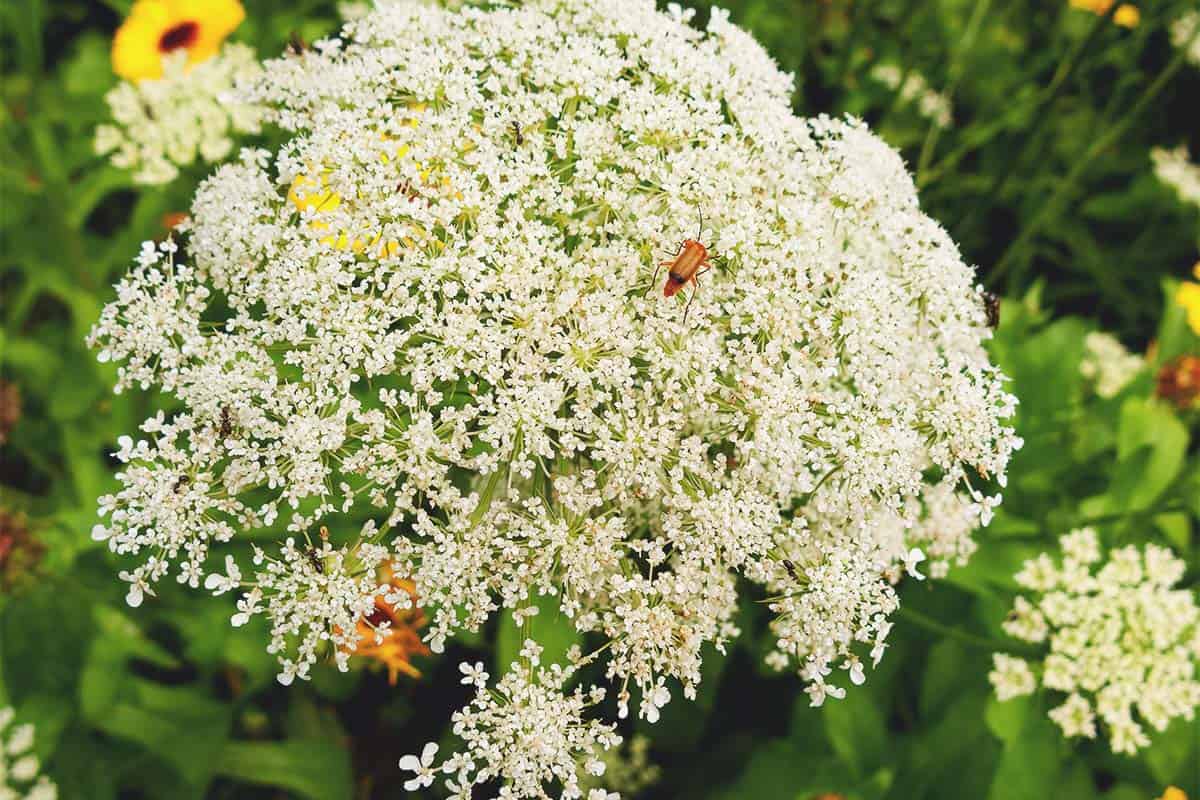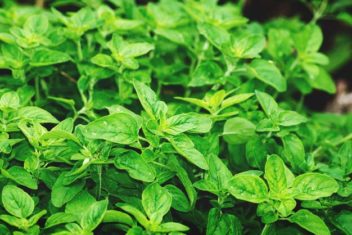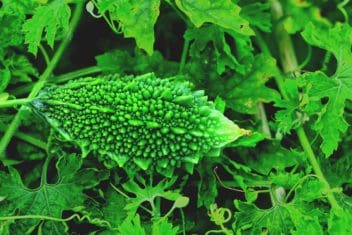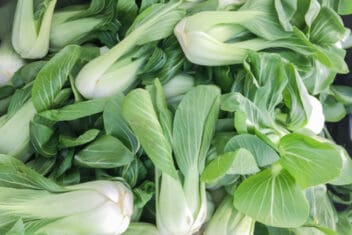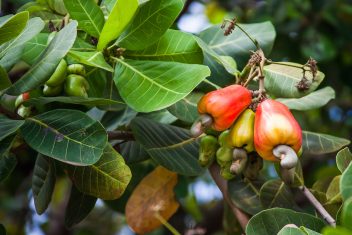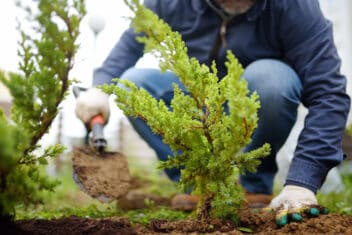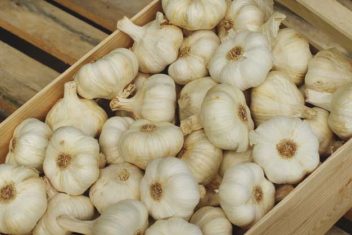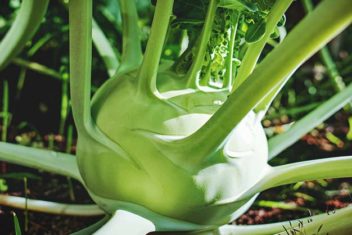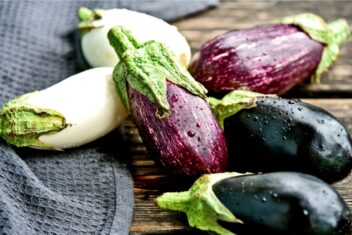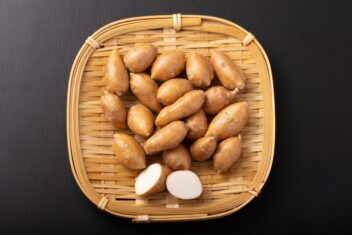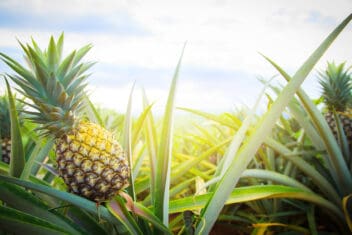Angelica (Angelica archangelica) isn’t a well-known herb and it took me a while to find the seeds. That’s a shame because angelica tastes amazing and is invaluable in the medicine cabinet. It deserves to be growing in every garden.
This member of the parsley family is a biennial that grows in the first year and then flowers in the second year. You can use it as a flavoring in gin and vermouth, so if you love a gin martini, you’ll love angelica. It’s also delicious as a tea, made into candy, or baked into a cake. The flavor reminds me of licorice.
Angelica is also a star as a medicinal herb. In the past, people believed the roots protected against the plague along with a range of other diseases. It’s also said to bloom around the feast of Michael the archangel, hence the name. Today, there’s some evidence it can help with heartburn, lack of appetite, anxiety, and insomnia.
You can use the roots, leaves, and seeds, and the musky scent is a pleasure to have in the herb garden, and the plant is quite pretty.
Because of its large size, angelica is good for rear borders. Its towering height makes it a real standout in the garden. It’s also a water lover, so you can use it near water gardens, wetlands, naturalized areas, around ponds or on the banks of ponds or streams.
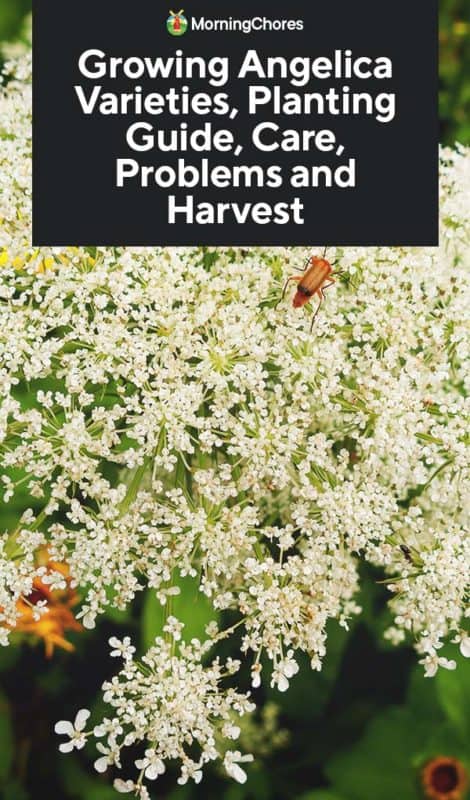
How to Plant Angelica
Angelica takes a bit of space compared to some herbs, which can be a nice change from some of the smaller plants out there. Just make sure that you buy angelica archangelica as other angelica are sold as ornamentals and aren’t edible.
The non-edible angelica has shiny leaves, the opposite to edible angelica which has dull green leaves.
Zones
Angelica grows well in zones 4 to 9.
Sun Requirements
Plant the herb in partial sun if you live in a particularly hot or sunny area. Plant in full sun otherwise. I’ve found angelica grows best in dappled areas where there is an equal amount of sun and shade.
Soil Requirements
Angelica likes free-draining soil with a pH of 4.5 to 7.4. Cultivate a soil that is rich organic matter. Although angelica prefers soil that is free draining, don’t let it dry out. Try to retain moist soil.
When to Plant Angelica
Plant in early to mid-spring for summer harvest if you have kept the seeds in the fridge.
Either leave the seeds to do their own thing and self-seed or, if planting for the first time, plant in mid-to-late fall so that the seeds spend the winter in the soil. I prefer to let angelica self-seed, as long as it doesn’t spread too much.
Container Planting
Angelica does well in pots, but you need a container at least 16 inches in diameter and 12 inches deep. Mix a bit of sand or perlite in with a good quality potting mix and water regularly.
Planting Seeds
Gather seeds from your plant or purchase seeds and place them in the fridge. Angelica needs cold stratification, and this process also kills any nasty aphids that may be present. Keep in the fridge for at least a week before planting.
If you can’t plant them out straight away, leave them in a jar in the fridge until the following spring. Angelica seeds need light to germinate so just gently press them into the soil, rather than burying them.
The seeds need about 4 weeks of temperatures above 60 to 70°F to germinate after overwintering.
Spacing
Plant at 2-foot intervals or closer if you plan to thin the young plants out. Angelica grows up to 4 to 7 feet tall and 2 to 4 feet wide, so it requires a bit of space.
I’ve always planted angelica at the back of the garden with the smaller herbs in front.
Dividing the Root
You can divide the roots of angelica and replant. Dig up your angelica plant roots on the second year around fall. Split the roots with a sharp knife and repot in potting mix or directly into the soil.
Caring for Angelica
Angelica isn’t a hard plant to grow and it isn’t too fussy. It will tolerate most conditions. It self seeds easily.
Fertilizer
Fertilize once a month during the growing season with a good quality all-purpose fertilizer. Although angelica is a hardy grower, it benefits from the boost of nutrients.
Watering
Water well, but don’t saturate the soil. If anything, give angelica a little less water than other water-hungry plants because it will hold water reserves in its roots if the soil gets a little too dry.
Pruning
Angelica flowers grow tall and may fall over in strong winds, but don’t require pruning. The plant will die back in the winter, so I prune it to ground level or slightly higher for aesthetic reasons.
Some gardeners prune the seed heads off before they ripen to prolong the life of the plant, but if you’re like me, I let angelica grow, flower, dieback, and self-seed all on its own.
Mulching
Mulching isn’t always a necessity for angelica, but if you live in a hot or sunny area, mulching can reduce the amount of water evaporation to keep the plant happy.
Companion Plants for Growing Angelica
Plant angelica with:
Don’t plant near:
Common Problems and Solutions for Growing Angelica
Although angelica is a hardy herb, like all plants it is susceptible to some problems. The good news is that it attracts beneficial insects like honey bees, predatory wasps and ladybugs.
Aphids
Aphids seem to attack any plant, but angelica is particularly vulnerable to aphids when young. The little buggers will suck the life from your angelica plant. I use a regular application of neem oil as a deterrent and blast the bugs off the plant when they show up using a strong spray of water.
Slugs and Snails
Once again, angelica is vulnerable when young to slugs and snails who seem intent on eating the plant completely. Use your favorite snail-control method. If you choose pellets, pick ones with a bittering agent so your pets don’t eat them.
Leaf Miners
Leaf miners cause more of an aesthetic issue, but if your infestation is large, they can stress your angelica plant by devouring the fleshy part of leaves. Use neem oil or a good organic pyrethrum spray.
Powdery Mildew
You’ll know if you have powdery mildew on your angelica because you’ll clearly see the white powder on the plant.
Use a good fungicide, though angelica is usually only effected by powdery mildew when its young or when humidity is high over long periods. Avoid it in the future by watering angelica at the base of the plant, not the leaves.
Harvesting and Using Angelica
You can use the leaves, roots, and seeds of the plant. For that reason, I’ve found angelica to be one of the most useful herbs in my garden.
Harvest the stems around April and May in the second year. Harvest the roots in the fall of the first year.
Angelica seeds don’t stay viable for long once they ripen in mid-to-late summer, so if you want to use the seeds to germinate new plants, pick them quickly.
The stem of the plant can be candied or used in cakes and puddings. You can just peel and blanch the stems if you want. They taste a little like celery. Candied stems will keep in a container in the cupboard for several months.
Young leaves can be boiled. Treat them like spinach or make a tea for sore throats and colds. You can make a refreshing tea with the leaves or seeds, but I find the seeds a little too bitter. You can store the leaves wrapped in a damp kitchen towel for a few days in the fridge.
The seeds can be burned to use as a room deodorizer.
The Bottom Line on Growing Angelica
Growing angelica is a lot easier than some of the fussier herbs out there. It benefits from a little care and feeding, but you can petty much plant and forget as long as you give it water. For such a low-maintenance plant, it has a lot to offer as a tea, medicine, or candy. Let us know how you like to use it best!
